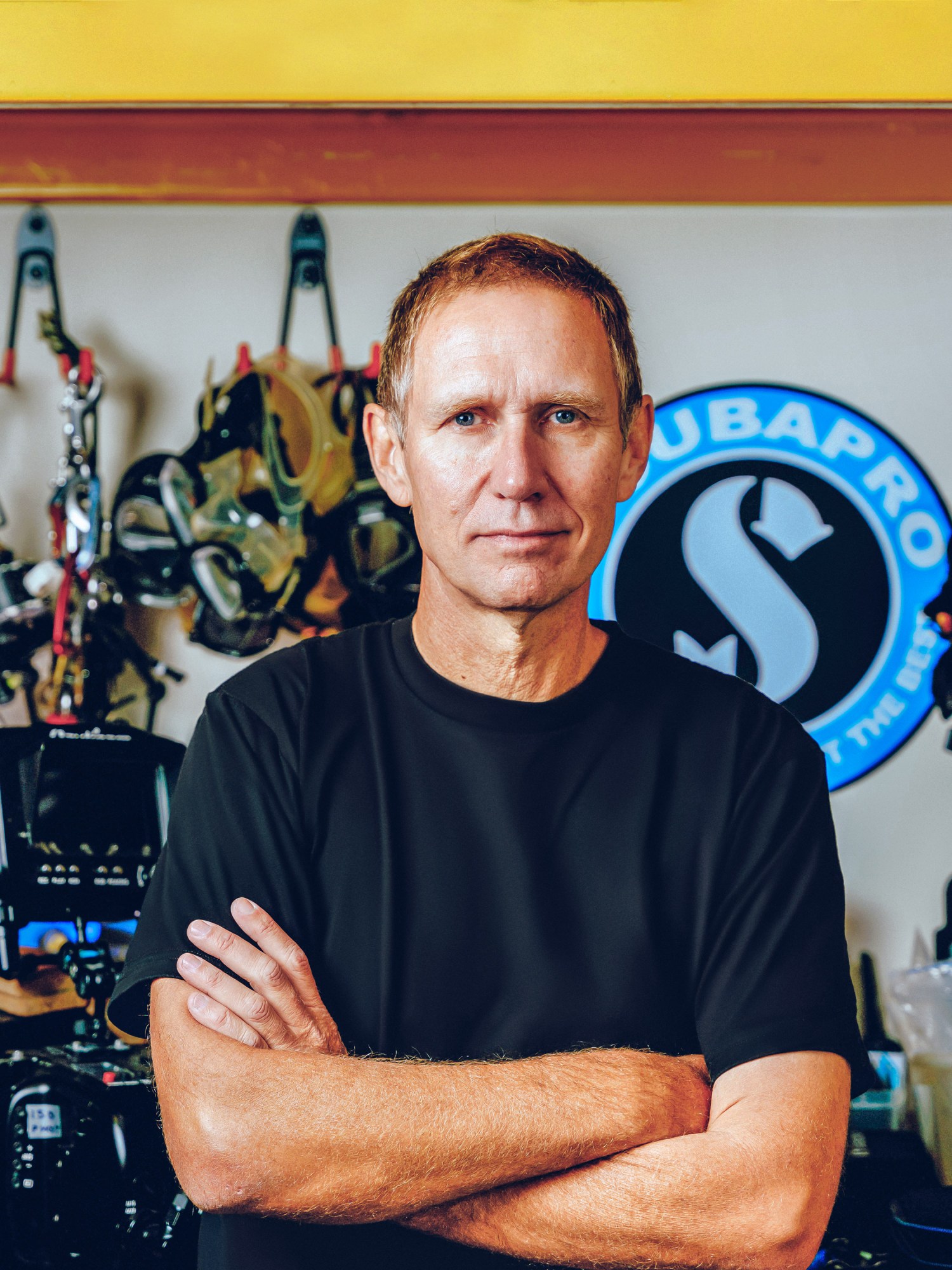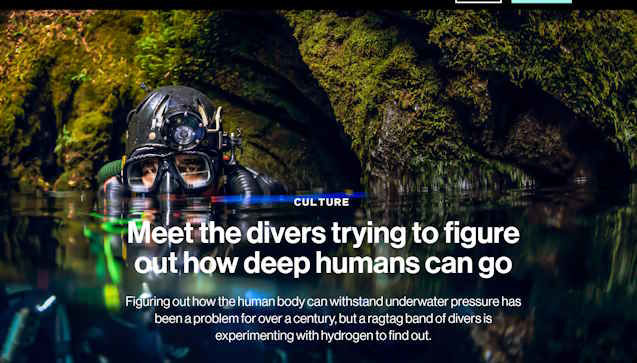Part 1 of 2. (Photo: SIMON MITCHELL)
Two hundred thirty meters into one of the deepest underwater caves on Earth, Richard “Harry” Harris knew that not far ahead of him was a 15-meter drop leading to a place no human being had seen before.
Getting there had taken two helicopters, three weeks of test dives, two tons of equipment, and hard work to overcome an unexpected number of technical problems. But in the moment, Harris was hypnotized by what was before him: the vast, black, gaping unknown.
Staring into it, he felt the familiar pull—maybe he could go just a little farther. Instead, he looked to his diving partner, Craig Challen, floating a few feet to his right. They had both been diving increasingly dangerous and unplumbed caves for years, making them two of only a handful of people with the skills to assist in the rescue of the Thai soccer team that got trapped in one in 2018. They knew extreme risk, and each other, well. Even through the goggles and the mouthpiece of the breathing apparatus, its four thick hoses curling around his face like mammoth tusks, Harris could see that Challen felt the same way. They both wanted very badly to push forward into the dark expanse.
Instead, on Harris’s cue, they turned back. They weren’t there to exceed 245 meters—a depth they’d reached three years earlier. Nor were they there to set a depth record—that would mean going past 308 meters. They were there to test what they saw as a possible key to unlocking depths beyond even 310 meters: breathing hydrogen.
The problem has existed for more than a century: How can a human body withstand underwater pressure significantly past its natural threshold? Naval units and offshore oil companies around the world have long been invested in figuring it out for power and profit, and in the 1970s and ’80s their research began filtering into the civilian world, where people were testing the limits of their own curiosity.

In 2023, Richard Harris made an experimental dive to determine whether hydrogen could enable exploration at greater depths. COURTESY OF RICHARD HARRIS
This included people like Sheck Exley, a high school math teacher in Live Oak, Florida. Exley became an international icon in the diving community for his record-breaking dives—exceeding, in some cases, the limits of the military and commercial professionals. He had been diving the underwater caves of North Florida since he was a teen—by 1972, at age 23, he was the first person in the world to log 1,000 cave dives—and exploring them is what pushed him to go deeper. He’d been hooked since his first cave dive in Crystal River, Florida, in 1966. “I kind of wandered off into the cavern there, my eyes adjusted, and I swam a little bit further, peering off into the darkness,” he told AquaCorps, a magazine for divers, in 1992. “I guess I’ve been peering off into that darkness ever since.”
At around 40 meters, breathing the gas mixture we call air—78% nitrogen, 21% oxygen, and 1% trace gases—causes inert gas narcosis, or the “martini effect,” named for the incapacitating state it induces. A little deeper and oxygen becomes toxic. For years, the US and British navies had been using helium to dilute the oxygen and nitrogen in a diver’s tank as a means of counteracting both these problems, but few outsiders knew about it. In 1981, after the German cave diver Jochen Hasenmayer reached 143 meters using a helium mixture, Exley started using it as well—despite the knowledge that only a few years earlier, two divers in Florida had experimented with the mixture and died.
Divers who go past 40 meters typically don’t use a constant gas ratio—they cycle through mixes of nitrogen, oxygen, and helium as they descend and ascend, modifying them according to location, water temperature, neurological tolerance to narcosis, and many other variables. Decompression tables, which lay out different gas mixtures and the amount of time to be spent breathing them, provide a precise road map for this process—very necessary, as ascending too quickly releases the accumulated gases in a diver’s blood and tissue the way unscrewing the cap on a bottle of soda releases bubbles, resulting in the painful, often debilitating condition known as the bends. Without the tables, ascending from great depths was too risky. But generating them required high-level technology and archives of data unavailable to most people.
Exley was able to persuade a friend who worked in commercial diving to give him a sample table, which he used to extrapolate past 121 meters, working everything out on his computer. In 1987, guided by this information, he used helium to successfully break the 200-meter diving barrier at Nacimiento Mante in Mexico—a 24-minute descent that forced him to stay underwater for 11.5 hours to decompress. Over that period, he felt himself becoming dangerously weak. His blood sugar dropped, the cold seeped into his limbs, and his exposed hands and face began to grow wrinkly, become raw, and then flake. “At the time I felt I could have dived deeper,” he told InDepth magazine that year. “But I knew that I had reached my decompression limits.”
In 1988, Exley beat his own record, hitting 237 meters using a more precise table generated by the physiologist Bill Hamilton. Known among divers as “The Prince of Gases,” Hamilton had been involved with some of the earliest work on decompression past 200 meters.
He had helped develop a computer program that generated extremely precise tables calibrated to any number of parameters, which he created for commercial diving companies and navies around the world. “Through them, he had staggering amounts of data,” says Bill Stone, an aerospace engineer and cave diver who built and sold an early rebreather—a type of breathing apparatus that recycles exhaled air by scrubbing it of carbon dioxide. “He processed all that and developed stochastic models that figured out where you could gain speed on decompression and not hurt yourself.” In the ’80s, Hamilton made the unprecedented move of creating custom tables for people who were not commercial or military divers, forever endearing him to the diving community.
But in 1994, Exley died attempting to reach the bottom of the Zacatón sinkhole in Mexico, 332 meters down—he got to 270 meters. A likely factor was high-pressure nervous syndrome (HPNS), a neurological condition involving uncontrollable tremors brought about when a diver descends too rapidly at high pressure past 150 meters. Adding nitrogen to the mix of helium and oxygen could help—nitrogen’s narcotic effects could dampen the symptoms. But at that depth, adding more nitrogen would make it more difficult to breathe because of the gas’s density, and the narcosis would be debilitating.
Divers still pushed past Exley’s record into 250 and then 300 meters, white-knuckling through the HPNS symptoms. But at such depths, helium becomes too heavy for the human body to process. “As you go deeper, for every 10 meters you get an extra atmosphere of pressure—so once we’re down at those depths of 250 meters, that’s 26 atmospheres,” Challen, Harris’s dive partner, told me. “It becomes a physical problem of moving the gas in and out of your lungs.” In order to alleviate this problem, divers would need to breathe something lighter than helium.
“And we’ve only got one lighter gas to use,” Challen says. “After hydrogen, there’s nothing.”
What became known as the H2 Working Group began as a “thought experiment,” according to Michael Menduno, a veteran diver and editor in chief of InDepth magazine, who brought everyone together in collaboration with John Clarke, the former scientific director of the US Navy Experimental Dive Unit. It was also a way to socialize the way scientists, engineers, and tinkerers know how: by arguing over how to make something work.
The idea for the working group emerged in 2020, when Menduno, while researching an article on deep dives past 250 meters, concluded that the diving world had reached its limit with helium. Exley himself had pointed to what he saw as the next step in reaching unprecedented depths: “From what I’ve been learning, there seems to be some real potential for hydreliox”—that is, an oxygen-helium-hydrogen mix. Still, “no one has looked at its use for deep bounce dives,” he told Menduno in a 1992 interview, referring to dives without the use of a chamber to help the diver reach a safe gas saturation point before venturing into the water.
When the group formed in that year, at the beginning of the pandemic, Menduno was familiar with previous attempts to use hydrogen. In the ’90s he had traveled to France to watch a team of medical doctors, engineers, scientists, and trial divers from Compagnie Maritime d’Expertises (Comex), a Marseilles-based company focusing on deep diving systems and equipment, attempt to pass 701 meters in a hyperbaric chamber pumped with a hydrogen gas mixture. (It required 15 days of compression and 23 days of decompression.) This was Hydra 10, part of a series of experiments using hydrogen. After Hydra 12, in 1996, the project had scrapped pursuing hydrogen altogether. Companies were turning to manned underwater vehicles and saturation diving—that is, staying at extreme depths long enough to allow the inert gas to fully dissolve in a diver’s blood, which is only possible with a chamber. “[In commercial diving] there’s no poetry, no sense of humor—you just want to be efficient,” says Jean-Pierre Imbert, who worked on the Hydra project and had invited Menduno to observe the experiments in the ’90s.
In 2012, building on Comex’s work, a team of Swedish divers, called the Hydrox Project, had successfully breathed a mixture of hydrogen and oxygen for five minutes at 40 meters. They were hesitant to share the information, concerned that people without the expertise might make the attempt at their peril. “We didn’t publish or tell too much about how we did it, because we believe if you do this wrong—you have to understand it, or you will fail miserably,” diving engineer Åke Larsson, one of the members of the Hydrox Project, later said. “But it’s not rocket science. If you do your homework, it’s not complicated. But you have to do it right.”
To be continued...











